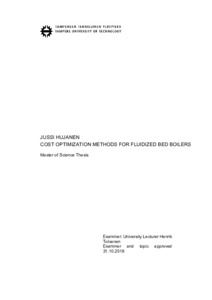Cost Optimization Methods for Fluidized Bed Boilers
Hujanen, Jussi (2018)
Hujanen, Jussi
2018
Ympäristö- ja energiatekniikka
Teknis-luonnontieteellinen tiedekunta - Faculty of Natural Sciences
This publication is copyrighted. You may download, display and print it for Your own personal use. Commercial use is prohibited.
Hyväksymispäivämäärä
2018-12-05
Julkaisun pysyvä osoite on
https://urn.fi/URN:NBN:fi:tty-201811222751
https://urn.fi/URN:NBN:fi:tty-201811222751
Tiivistelmä
In this Master of Science thesis, the operational cost structure and a method to optimize this structure are studied. The whole operational cost structure and different basis for optimization are presented. Optimization of the soot-blowing cycle was chosen as the studied method as it is a feasible target for optimization from technical point of view and it is linked to the cost structure in a straightforward manner. This thesis of focused on the most common form of fluidized bed boilers, circulating fluidized bed boilers, but the theory and studied method are for the most parts also applicable to bubbling fluidized bed boilers.
Research targets of this thesis were to identify factors that form the operational cost structure of a circulating fluidized bed boiler, to identify the most critical Key Performance Indicators from cost point of view and to study the feasibility of soot-blowing optimization as a cost optimization method.
This thesis is divided into theoretical and computational parts. In the theoretical part the techno-economic background of circulating fluidized bed boiler technology is introduced, including the operational cost structure of circulating fluidized bed boilers. Theory of Key Performance Indicators and state of the art references regarding soot-blowing optimization are presented in their own Sections.
In the computational part the developed method for soot-blowing optimization is presented. This method was applied to six different power plants and the most cost optimal soot-blowing cycles for these power plants were calculated from history data based on the behavior of flue gas losses between soot-blowing cycles. The results clearly indicate, that power plant operators initiate soot-blowing cycles too often as in all inspected cases the calculated optimal cycles were longer than the cycles that were used on average. The calculated potential savings on a yearly level varied from 200 to 12 800 tons of fuel. These results clearly indicate, that soot-blowing optimization is a feasible cost optimization method in fluidized bed boilers.
Research targets of this thesis were to identify factors that form the operational cost structure of a circulating fluidized bed boiler, to identify the most critical Key Performance Indicators from cost point of view and to study the feasibility of soot-blowing optimization as a cost optimization method.
This thesis is divided into theoretical and computational parts. In the theoretical part the techno-economic background of circulating fluidized bed boiler technology is introduced, including the operational cost structure of circulating fluidized bed boilers. Theory of Key Performance Indicators and state of the art references regarding soot-blowing optimization are presented in their own Sections.
In the computational part the developed method for soot-blowing optimization is presented. This method was applied to six different power plants and the most cost optimal soot-blowing cycles for these power plants were calculated from history data based on the behavior of flue gas losses between soot-blowing cycles. The results clearly indicate, that power plant operators initiate soot-blowing cycles too often as in all inspected cases the calculated optimal cycles were longer than the cycles that were used on average. The calculated potential savings on a yearly level varied from 200 to 12 800 tons of fuel. These results clearly indicate, that soot-blowing optimization is a feasible cost optimization method in fluidized bed boilers.
